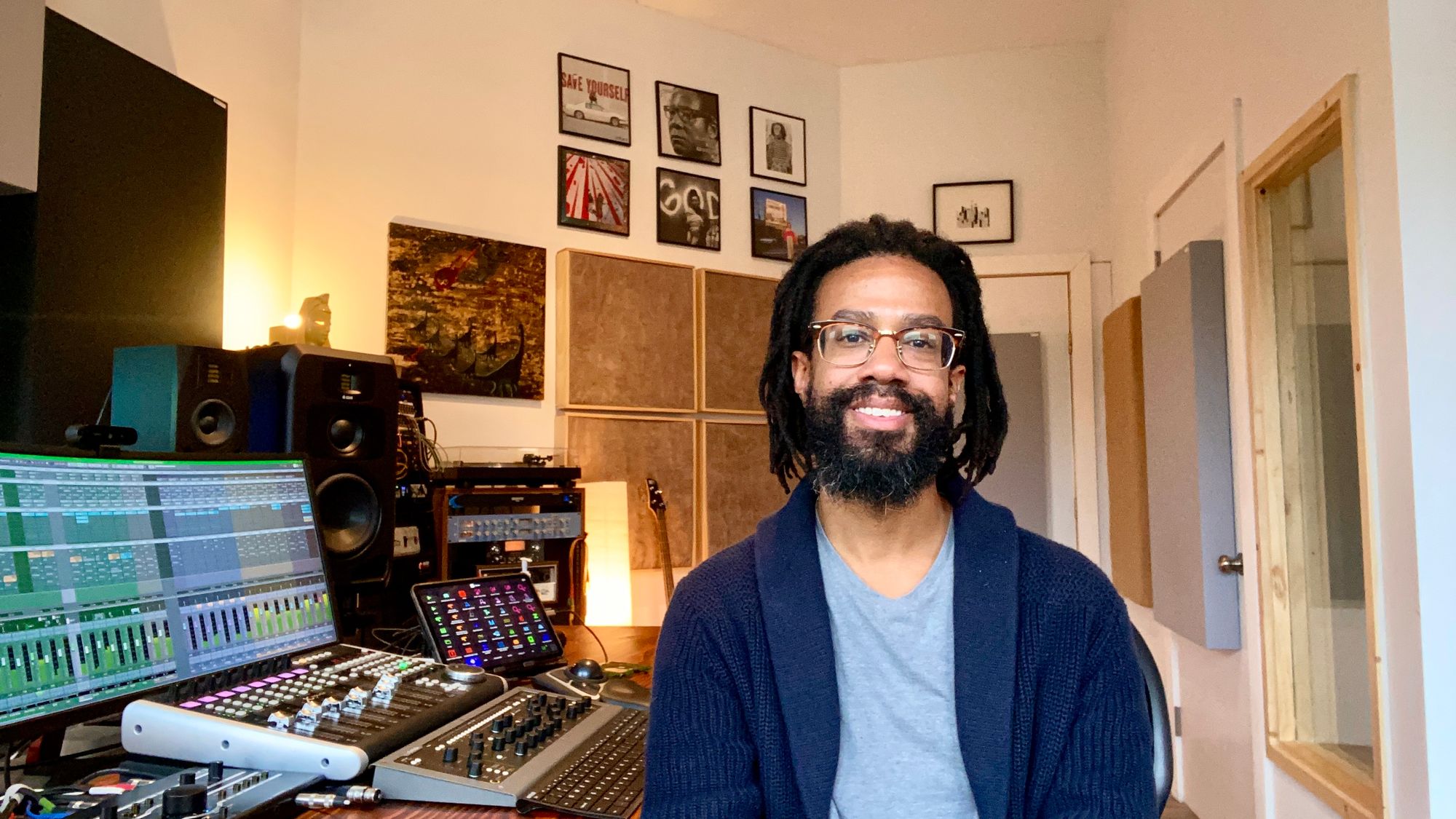Meet USF’s new hip-hop and R&B professor: Artist and engineer ‘Willie Green’

When Paul “Willie Green” Womack graduated from the Berklee College of Music in 2003, hip-hop and R&B felt like “outliers” in music education.
“I felt encouraged and supported by my faculty and department, but I don’t think the music or academic industry really embraced hip-hop at the time,” he says. “There were preconceived notions that it wasn’t academic or a high-level artform.”
But as an artist, producer, engineer, and educator, Green is part of a growing generation of academics working to change that. For the past two years, he’s taught hip-hop and R&B courses at SUNY’s Purchase College in New York. He’s also taught Master Classes online, sharing his skills in music production, mixing and intentional listening.
Throughout his career, Green has worked with such artists as Wiz Khalifa, The Roots, Roc Marciano, Open Mike Eagle, Billy Woods, and Murs—just to name a few.
Now, Green is working with the University of St. Francis (USF) in Fort Wayne as an artist in residence, leading its first hip-hop and R&B concentration within the music technology program. This fall, he will be teaching students both remotely and in-person, with a few opportunities for the broader Fort Wayne community to attend his lectures and events, too. (Details TBA.)
Classes begin with the storied history of hip-hop and R&B, which happens to coincide with the 50th anniversary of hip-hop’s birth in the South Bronx this year.
“I like to say: There’s no such thing as a 50-year fad,” Green says. “Hip-hop has become the most impactful genre in the music industry, and we need to give it the same academic look as other genres.”
We sat down with Green to learn more about his music, his courses, and his advice for growing Fort Wayne’s music scene.

Tell us more about your background. How did you get into R&B and hip-hop?
WG: I grew up around music. My uncle (and godfather) is a musician, and he gave me my first keyboard and drum machine at the age of 8. Being born in the early 80s, by default, I experienced the early portion of hip-hop, and that was the music I had around me growing up. My cousins gave me mixtapes of Snoop Dogg and Redman. My sister was a huge Janet Jackson fan, so music was always on in the house.
As I grew up, I started to explore music on my own, too. The first time I heard the Wu-Tang Clan’s 36 Chambers album, it blew my mind. I was like: I didn’t know music could sound like this, coming from a more R&B and traditional production background. Wu-Tang set me off on the path toward hip-hop, but also on the search for different and unique sounds.
That still defines my style today, in a lot of ways. As a musician, I’m not someone who wants to sound like everyone else. I want to do something different and unique, and I’ve been able to do that in hip-hop and carve my own path. I work in art rap, doing avant garde, unique stuff where I’m able to try more experimental things, and I’m lucky enough to make a career out of it.
How would you describe your own music style?
WG: That’s a hard question. Maybe “challenging.” I enjoy music that makes you think and work a little bit. Many artists make good songs to put on while you’re driving or doing the dishes, but I like to make active music. I want people to sit down and listen to it, not just have it on in the background. That’s not to knock other styles; it’s just my preference for creating and for teaching.
In my classes, I try to teach students how to listen to make their own judgements and artistic decisions in a thoughtful way. Getting people to really think and be critical is the nature of who I am and what I do for a living. Most of my teaching ends up being taught through the lens of hip-hop because that’s the musical language I speak the most often.
Tell us more about how you got involved with the program at USF and what makes hip-hop an important genre of music to teach?
WG: Hip-hop is interesting in that it’s not just about the music. There are a lot of aspects to it: The fashion, the art around it and the techniques involved in creating the music.
Rhyming itself is such a unique skill. Sometimes, people will look at rappers, and say, “That’s not a skill; anybody can say words that rhyme.” But does it sound good? Does it motivate you and have a message? It’s such a complex, deep artform with a lot of moving pieces to it. That’s what interested me in the program at USF.
Miles Fulwider (who directs the music technology program at USF) is a friend and colleague of mine from the Audio Engineering Society (to which we both belong). We were speaking about the program USF was developing, and he asked if I would consult on the curriculum and offer my thoughts.
When I looked into it, I was really impressed with the wide range of the program, where there are obviously production courses, engineering courses and beat making courses involved, but also courses on the history and the culture of hip-hop, too. A lot of universities are starting to make hip-hop and R&B a bigger part of their academic track, but how they are looking at it and addressing it is also very important, and I was impressed with what USF is trying to do.
This fall, the first course you’re teaching is the history of hip-hop and R&B. Tell us a little bit about that.
WG: The history of hip-hop and R&B is very important because the social conditions of the South Bronx in the early 70s really led to the creation of hip-hop. It’s interesting to have a musical genre or artform where you can point to a specific day and year where you can say: This is when it was invented, the phrase was coined, and people beat juggled on turntables and created the loops that define what we do today.
With hip-hop, we know the date and address where it happened. To say it was born at an end of summer party at 1520 Sedgwick Ave. in the Bronx is really fascinating, and because it's so tied up in the culture, society and race, all the microcosms of life itself. Hip-hop has all of that within it.
Another really impressive course USF is offering as part of this program is the culture of hip-hop, which involves helping students determine where they fit and find themselves within the culture, which has become so large and all-encompassing.
Speaking of hip-hop culture, tell us more about its influence on the music world and how it is evolving.
WG: Hip-hop’s influence truly is global. I’ve been lucky enough to do international tours where I’ve spent time in Europe or with people on the other side of the planet who have little in common with my daily life. But we can connect immediately because we have this commonality of hip-hop. Within that, there are definitely regional aspects to it, too. Hip-hop in Detroit doesn’t sound like New York hip-hop or hip-hop in Prague, but there are similar elements that bring us all together.
That’s one reason I think it’s important for students to learn, not just the technical aspects of hip-hop, but also the cultural aspects of it and why it means so much to so many people.
It’s not necessarily new, but I think hip-hop and R&B are evolving in ways that now are impacting every other genre, whether it’s the bass on modern country songs or pop singers, like Taylor Swift, rapping with Kendrick Lamar. I think it’s hard to be a modern record producer without a bare minimum understanding of hip-hop. You’re going to deal with loops and drum programming, which used to be the bastion of hip-hop, but now, it’s just the way we make records.
Overall, I’m a big believer that: No matter what your primary genre is, you need to understand what’s happening in other genres, too. So you can say: I know in indie rock they're doing this, but I'm not going to do that in rap. You need to understand something before you can properly dismiss it. It’s in our culture to dismiss things before we have the context, but it can only help you make better decisions on what you do and don’t want to put in your music by expanding your knowledge base.
Can you tell us anything about what to expect from your courses at USF so far?
WG: We’re still nailing down the final details, but in general, with my first course on history, I want to teach the history of hip-hop through the timeline of important albums and records. I feel that’s a critical way to tell the story because music isn’t created in a vacuum. The Sugarhill Gang’s “Rappers Delight,” in the late 70s informed what DJ Jazzy Jeff & the Fresh Prince did in the late 80s, which informed what Jay-Z did in the late 90s. There’s a lineage, and everything is built off something else, so you have to talk about important artists and programs along the way.
Overall, in teaching hip-hop, I don’t want to forsake the music itself for books and dates. It’s more about: Do you understand the impact Public Enemy had when they released their debut album? And you need to understand the music to understand the impact.
For those who don’t attend USF, is there a way we can benefit from your teaching, too?
WG: Even though I’ll be teaching remotely (my family is based in Brooklyn), I’ll be coming out to Fort Wayne a few times during the semester to do Masters Classes and events. And some of those events will be open to the public. We’ve got some big things planned and some good stuff in store, so watch out for updates this fall about when I’ll be in town.
Fort Wayne is looking to grow its music scene and encourage more artists to live and work here. What do you think makes a good “Music City”?
WG: This will be my first time in Fort Wayne. I know a few people there, and I know that Sweetwater is there because I have purchased there many times. But beyond that, I don’t know much about Fort Wayne yet, so I’m still learning. But what I think is really valuable for music scenes, in general, is investing within the local community—whether it’s venues, clubs, or opportunities for musicians.
As the world has become more global because of the internet and how widely we can spread music, I think people often look outside of their location more than look at what can be done within it. But music is still very regional, and for me, if I travel somewhere, I want to eat local food, drink local beer and go see local music there, so I know what music sounds like in Fort Wayne or Memphis or Des Moines. If I wanted to hear Brooklyn music, I would stay home.
Investing in the local music economy and building up that local sound is important. You have to focus on within first. When you have the foundation of your scene, it grows stronger.
